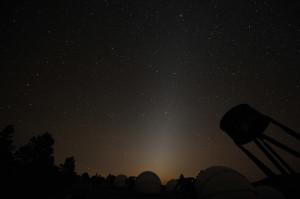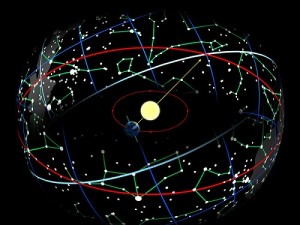What Is The Ecliptic In Astronomy
Along with the celestial equator, the ecliptic is one of two important lines that astronomers use to divide up the night sky.
Up until the early 1600s, the idea that the Sun orbited the Earth was perfectly acceptable to a lot of people. The reason our ancestors believed in this geocentric (Earth-centred) model was, of course, because that’s what we see happening in the sky. Or so it appears.
From our planet, it looks as though the Sun moves around us over the course of a year. As we now know, this isn’t really the case – in truth our planet orbits the Sun, as do all the other planets in the Solar System. But this illusion forms one of the most important markers on the sky, the line we call the ecliptic.
The ecliptic is the invisible path that the Sun traces as it moves around the sky. Think of it like this: if the Sun were to drop breadcrumbs behind it like a cosmic Hansel and Gretel, this is the trail it would leave behind. The Sun can always be found on the ecliptic – it never deviates from it. But it also represents something else: the orbital plane of our planet.
 All of the planets in the Solar System occupy orbital planes similar to our own. This is because when the Solar System formed, billions of years ago, dust and gas surrounding our nascent star was pulled into a disc under the influence of gravity.
All of the planets in the Solar System occupy orbital planes similar to our own. This is because when the Solar System formed, billions of years ago, dust and gas surrounding our nascent star was pulled into a disc under the influence of gravity.
The planets we know today all formed within this disc and hence they all occupy planes similar to the ecliptic. In plain terms, when the planets are visible, they will always be near to this line.
It’s this ‘coplanar’ nature of the Sun and planets that allows many of the events that captivate astronomers to occur so often. When our Moon and the Sun line up, we see an eclipse. When a planet appears to be in the same region of sky as another, or our own Moon, we call it a conjunction. Even seemingly rare events, such as a transit of Venus, are really quite frequent in cosmological terms.
Seasonal adjustments
If you look at a star chart, you may notice a second important line crossing the constellations, the celestial equator. This is simply a projection of Earth’s terrestrial equator into space. The celestial equator sits at an angle of 23.5” to the ecliptic – a result of Earth’s axial tilt. Using these two lines, we can make sense of the astronomical points that mark the start of the seasons.
 The points where the two lines meet mark the equinoxes, when day and night are the same length. In the northern hemisphere, the equinox in mid-March heralds spring, the one in mid-September the beginning of autumn. At these two points in its orbit, Earth has no tilt relative to the Sun.
The points where the two lines meet mark the equinoxes, when day and night are the same length. In the northern hemisphere, the equinox in mid-March heralds spring, the one in mid-September the beginning of autumn. At these two points in its orbit, Earth has no tilt relative to the Sun.
From the March equinox, the days slowly lengthen until mid-June, when Earth reaches the point in its orbit where it is at its greatest tilt relative to the Sun – a solstice. This is both the first day of summer and the longest day of the year. At this point, the ecliptic and the celestial equator are at their farthest apart.
There’s another solstice six months later in mid-December, when the tilt of the poles is completely reversed in relation to the Sun. In the northern hemisphere, this marks the start of winter and is also the shortest day.
